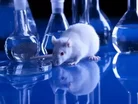[VIDEO] Novartis Studies Muscle Atrophy by Sending Mice into Space

Novartis’ BioMedical Research team is taking the phrase “out of this world” to another level. In their latest endeavor to understand the degradation of muscles, they have teamed up with NASA to send mice into space to study muscle atrophy.
Sent to the International Space Station on September 20, the mice will be living in microgravity during their mission, allowing scientists to learn more about muscle development and atrophy.
“If I had the opportunity to go into space, I would. But since I can’t, I will go vicariously through these mice,” said Sam Cadena, Investigator II at Novartis Institutes for BioMedical Research.
Cadena is part of the musculoskeletal group at Novartis, with its interest being in gene muscle loss, preserving muscle mass and maintaining function. Muscle loss being a primary concern for astronauts entering space, Cadena and his team were approached by CASIS, the Center for Advancement of Science in Space, and were asked if they wanted to be a part of the mission.
“Once the muscles of the astronauts are subjected to the microgravity in space, the muscles adapt to this new environment and they begin to atrophy and they get smaller,” said Cadena.
Although astronauts exercise for at least two hours a day while they are in space, this does not compensate for the load loss they experience without gravity, writes Catherine Hiller on Novartis’ site.
A Special Breed
The mice involved in this experiment are of no ordinary kind, they lack the protein “MuRF” – which stands for Muscle Ring Finger-1.
“What MuRF does is it labels proteins in the muscle for degradation and so these mice are highly resistant to muscle atrophy,” said Cadena. “The idea is to understand atrophy in any context that we can, and that includes space flight.”
Divided into two groups, one group of mice, dubbed “mousetronauts,” will be sent into space and another group will remain at the Kennedy Space Center to serve as the control group. Both groups will also be joined by normal mice to compare the differences in muscle atrophy.
“In the MuRF knockout mice, we expect to see less atrophy,” hypothesized Cadena.
Two Types of Testing
The extent of muscle atrophy is measured by muscle weights, according to Cadena. If the muscle weighed is lighter than its original weight, then it has atrophied.
“Another way to get a closer look is to look at the cellular level, and so this means taking cross sections of the muscle and looking at the individual cells to look at the size of the fibers – have they grown, have they shrunk?” noted Cadena.
Returning the Results Home
Muscle atrophy is more gradual on earth, but every human experiences muscle loss as they get older.
“I think where it’s most relevant is probably with aging,” said Cadena in regards to the study outcomes. “As people age they tend to get weaker, they tend to get frailer, some more than others and so it’s important because people want to maintain their independence as long as possible.”
“I think whether it’s in the context of aging or whether it’s in the context of chronic disease, muscle maintenance is important in keeping that independence and that functionality,” added Cadena.
Cadena hopes that this study will increase their understanding of the MuRF-1 protein and perhaps even accelerate the pace of muscle atrophy drug discovery in the field.
A second “mice in space” mission has been announced by Novartis to take place February 2015.
- Vaccines, Dementia & Food: The Week's Top Healthcare StoriesMedical Devices & Pharma
- Stanford: A Shingles Vaccine Could Cut Dementia Risk by 20%Medical Devices & Pharma
- What Does Eli Lilly’s US$3bn Dutch Pharma Investment Mean?Procurement & Supply Chain
- Supplies & Scope 3: This Week's Top 5 Stories in HealthcareProcurement & Supply Chain



